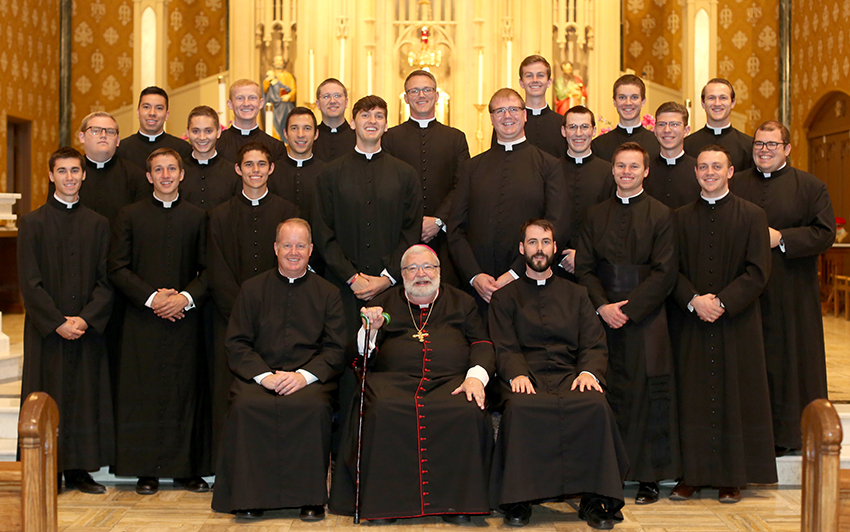COVID-19 pandemic sends seminarians back to diocese, but discernment continues

Seminarians of the Diocese of Peoria are pictured with Bishop Daniel R. Jenky, C.S.C., Father Patrick Henehan, vocation director of formation, and Father Timothy Hepner, vocation director of recruitment, in this photo taken last August at St. Mary's Cathedral in Peoria. (Provided photo/Nellie Gould)
When colleges and universities across the country suspended in-person classes for the rest of the semester to prevent transmission of COVID-19, the seminarians studying for the priesthood for the Diocese of Peoria were sent home, too. That doesn’t mean their discernment has been suspended, according to Father Patrick Henehan, diocesan vocation director of formation.
In the few short days since they returned, an intentional formation community has been developed to allow them to continue their spiritual and academic growth, he said. That includes having the seminarians live in rectories with their pastors or where they had served during summer assignments.
“We didn’t assign them to rectories because the idea was to give them places where they could feel comfortable almost immediately,” said Father Henehan, who is also pastor of St. Jude Parish in Peoria. “The idea was they could get right back to staying in the seminary mold.”
For some that included living at St. John’s Catholic Newman Center at the University of Illinois, where they felt a connection from their years as an undergraduate. Others are living with the priests at St. Mary and St. Patrick Church of Merna, both in Bloomington; St. Matthew in Champaign; St. Mary in Moline; St. Columba in Ottawa; St. Jude and the Heart of Peoria Catholic Community in Peoria; and St. Mary in Pontiac.
“The priests have been really generous in offering their homes and accommodating the guys,” said Father Timothy Hepner, diocesan vocation director of recruitment. “It should be interesting. They’re going to get a taste of life with priests, which they often do. It will be formative in its own way.”
“MEETING” ONLINE
Father Henehan said that while the seminarians are in parishes, the pastors will be “little rectors,” involving the young men in all the things they would have at the seminary, such as morning prayer, evening prayer, rosary, Mass and a daily Holy Hour.
“They’re still doing some formation and spiritual direction through the seminaries online,” he told The Catholic Post. Classes will continue the same way.
On March 20, Father Henehan “met” with the college seminarians online for night prayer. In addition to praying together, each one had a chance to talk about what has been going on before Father Henehan offered some instruction about formation.
“We plan on doing that at least once a week and maybe twice,” he said.
They’re all working out their plans and Father Henehan is working with them to make certain those plans are similar to the seminary.
He added that Bishop Daniel R. Jenky, CSC, and Msgr. Philip Halfacre, vicar general, have called every day to see how the seminarians are doing.
The original plan was to have the college seminarians stay in a wing of the motherhouse of The Sisters of the Third Order of St. Francis in East Peoria, with Father Henehan overseeing their formation. When the seminarians from Mount St. Mary were sent home, too, that plan was put aside for the health and safety of all concerned.
Father Henehan expressed his gratitude to Sister Judith Ann Duvall, OSF, major superior, and the members of the Franciscan community there for their “generous and magnanimous” offer.
GOD WILL PROVIDE
“Obviously I trust that God is going to provide all the graces that the guys need for their formation and their discernment,” Father Hepner told The Post, noting that it’s important to maintain a sense of calm and spiritual peace now.
“In some ways, this is going to be an extraordinary time,” he said. “What I’m excited for the guys to see is the pastoral heart of the priests. Lots of priests are trying to get creative and reach out to their people, so the seminarians are going to see that.”
It also has the potential to be a graced time, where their yearning and desire for the Eucharist increases and they realize they want to draw closer to the Eucharist by discerning priesthood, Father Hepner said.
“And hopefully they see the example of priests that are willing to risk themselves to minister to people,” he said, and that “they see the heroic sacrifice that is supposed to be inherent in the priesthood.”





